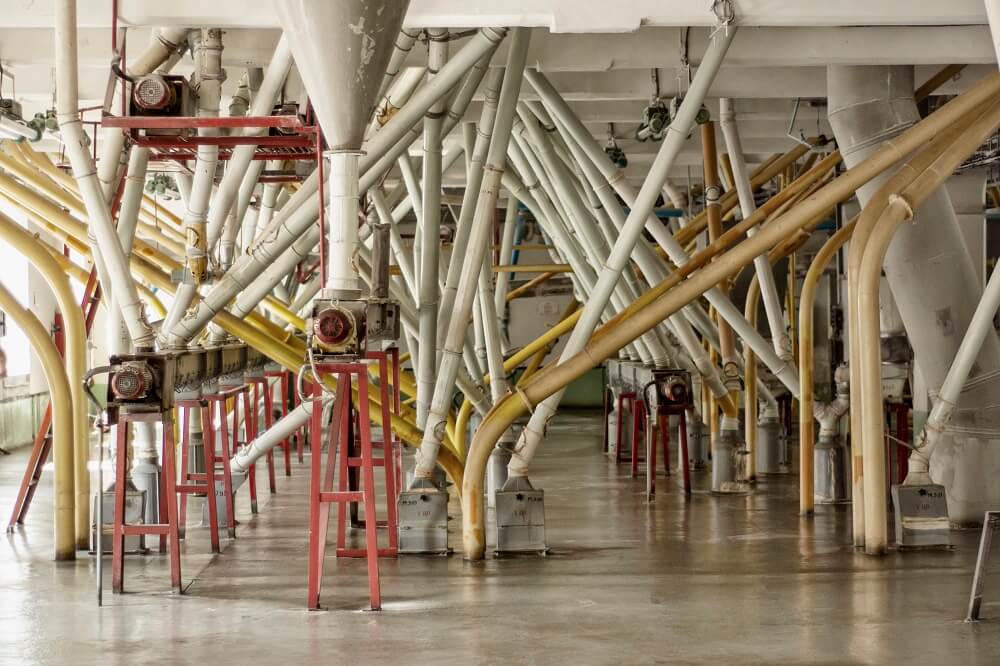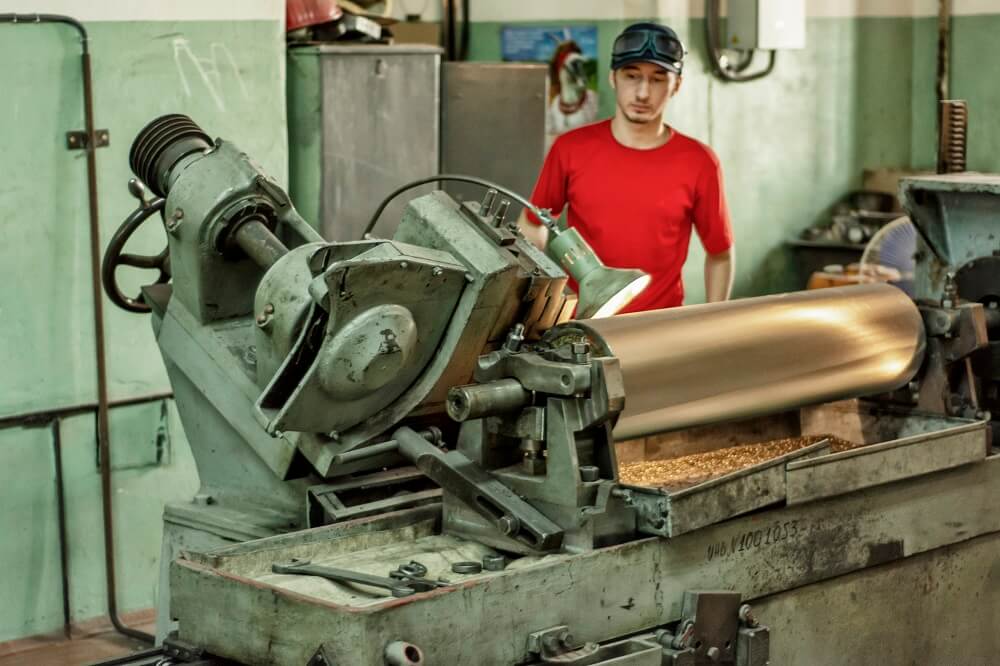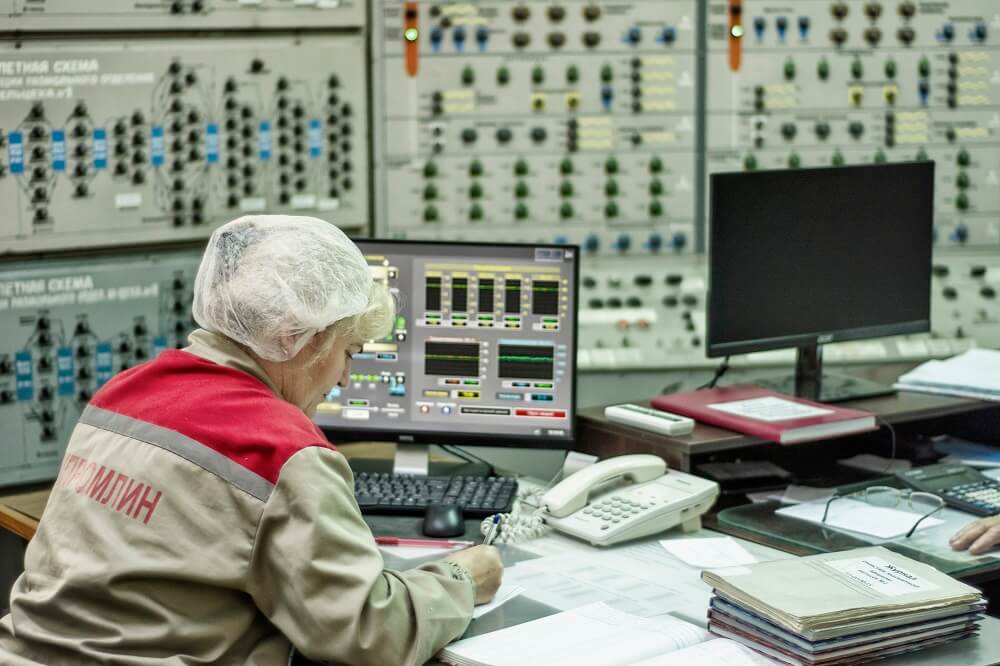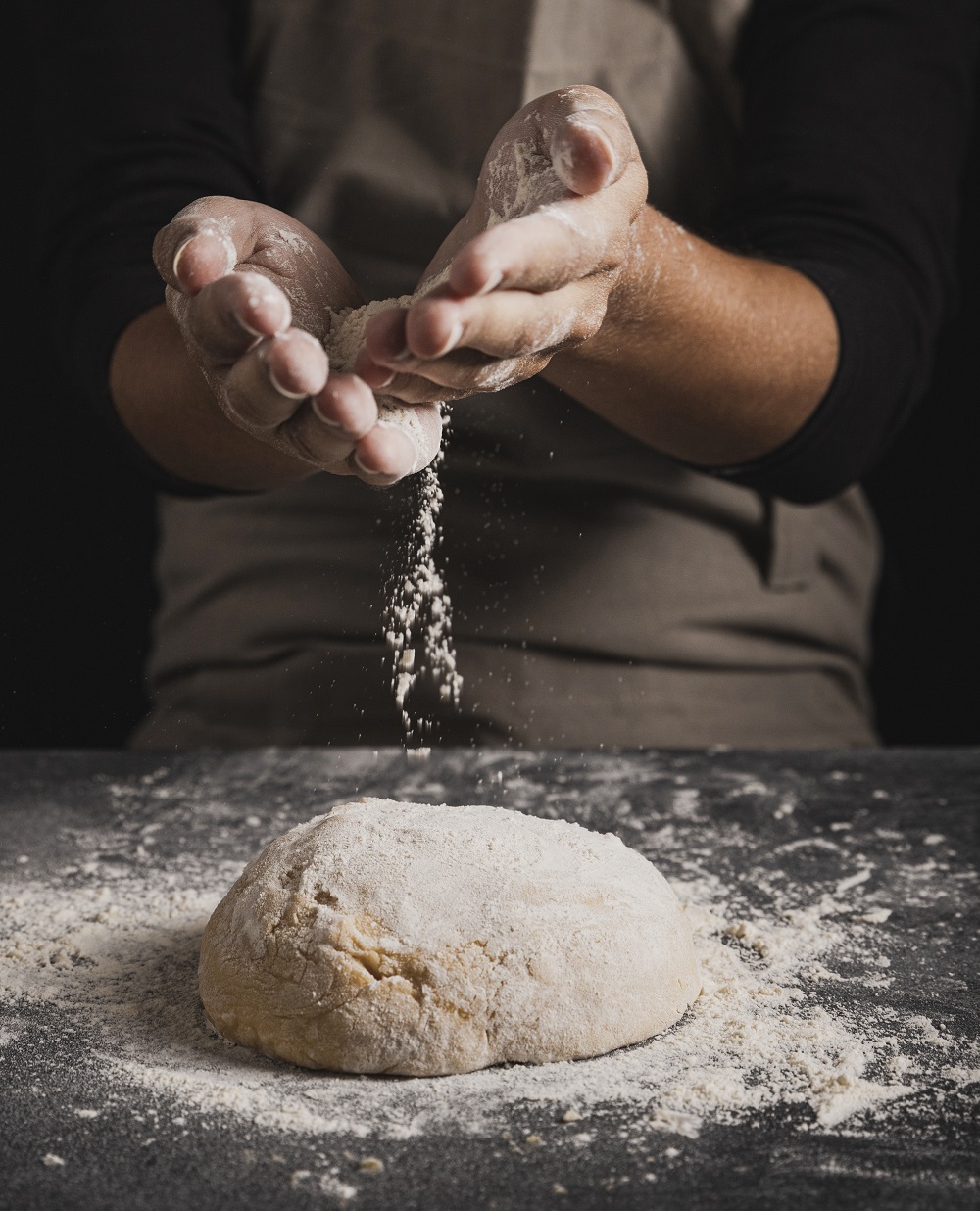PRODUCTION
Reception and storage of raw materials
Raw materials (grain of wheat, rye) are supplied to the enterprise by road and rail transport. Grain, which comes by road to the elevator number 1, 2 is first weighed on the central automobile electronic strain gauge scales “Ermak VA 60-2-20” with a carrying capacity of 60 tons.
Grain that arrives by rail transport is weighed on wagon scales with a carrying capacity of 150 tons. Sampling of grain samples from vehicles takes place at the expense of a porous type sampler. Elevator No. 1 allows storage of 14,000 tons of grain. Elevator No. 2 allows storage of 30,000 tons of grain.
Technological process of preparation and processing of grain
In the grain cleaning department, the grain is thoroughly cleaned from all kinds of impurities of an organic, mineral or industrial and domestic nature on special machines using a set of sieves and air flows. Grain-sized particles, which consist of metal or metal ores, are separated on magnetic separators. Particles of mineral origin: stone, asphalt, lumps of earth, are separated on the stone by selected machines.
Almost pure grain is intensively soaked and intensively mixed in wet peeling machines, where a partial separation of the fruit shell occurs.
After the grain has rested, it is again sent to the second stage of cleaning, where the husks of the grain and other parts left by chance are separated. After the secondary cleaning, the grain is again abundantly soaked and sent to the bunkers for the second resting for 2-3 hours. After passing, after that, through pneumatic separating machines, the clean grain is fed to the grinding department. In addition, the grain is soaked in the process of cleaning with hot water at a temperature of 30-40 °, which not only increases the effect of separating the fruit shell, but also strengthens the gluten of the grain. During hydrothermal treatment, grain moisture increases by 3-5%. The optimal technological moisture content of the grain entering the grinding process should be 15-15.5%.
Now comes the most important stage in the technology of grain processing - its grinding and flour production. A very long way to go through the grain until it turns into flour.




First, the grain is transported horizontally on the elevator and poured from top to bottom several times, passing a path 500 m long, in the grain cleaning department 300 m and in the grinding department 800 m. And total 1600 m, the grain will travel 1600 m to turn into flour and bran.
In the milling department, the main equipment for obtaining flour is roller machines, in these machines the grain, falling between two rolls pressed against each other and processed in such a way that the grain, falling between them, turns not into flour, but into intermediate products, easier in other words, the particles are large, medium and small of size. This is the main requirement of flour production technology. And after the rolling machine, the mixture of the crushed product is removed from the machine by an air stream and rises to the upper floor, where, separating from the air, the product enters for dispersion. Scattering is designed so that the product that enters it is divided by size into 3-5 fractions. Further, after dispersing, the particles flow in streams into the dispersing machines, where, passing through sieves with the help of an air stream, parts of the shells are separated from the grains.
Pure white groats are then sent to grinding roller machines, where they are crushed, turning into fine groats and dunst (the smallest). These small particles, once again passing through the cleaning systems, enter the machines of the grinding systems. There are 8-11 such grinding systems in the mill. To finally separate the floury part from the shell, the grinding product must go through all these 11 grinding systems.
In addition to flour, cereals and screenings, modern mills are provided with a system for selecting the grain germ. This product is a flat part of 2-2.5 mm size, yellow in color, according to its biochemical composition, it is the most valuable product, but due to its fat content of up to 14%, when it is ground into flour, it contributes to its rancidity. The germ itself is a valuable raw material for the production of medicines, vitamins, perfumes, and is used as a food additive in the confectionery industry. This product consists of: protein 30%, sugar 30%, 21 names of trace elements, a number of essential acids and vitamins, with the advantage of tocopherol (vitamin E).
Thus, the resulting flour is supplied by a varietal flow for control dispersion, where randomly dropped grain shells are separated, and the finished pure flour is sent by compressed air to the flour storage bins or to the beat out bins. From the beat out bins, the flour goes through the weighing machines to the warehouse or directly to the railway car. The enterprise has the possibility of shipping grain - groats, bran, both in bulk and in containers weighing 50 kg - wheat flour, semolina.
At packing No. 1, premium flour is packed in paper bags of 2 kg, as well as group packaging in thermo-packaging pellicle of 10 bags. At packing No. 2, premium flour is packed in paper bags of 1.5 and 10 kg, and semolina is also packed in 1 kg polyethylene packaging. There is also a group packaging of flour in thermo-packaging pellicle.
Advantages of the products of the enterprise DMK DNIPROMLYN LLC in comparison with the products of competitors:
In 2020, the enterprise turned 123 years old from the day of its creation. The advantages of the company's products are high quality, which meets all regulatory documents, as well as control of raw materials of products at each technological stage of production. An important role is played by the improvement and introduction of new technologies and equipment into technological processes.
During this period of time, the flour mill enterprise was reconstructed several times, modernization was carried out, technological and transport equipment was updated, and the range of products produced was expanded. All technical innovations are aimed at the production of high-quality products, the quality of which is confirmed by diplomas.

The receipt of these awards, first of all, was facilitated by the painstaking and daily work of the DNIPROMLYN enterprise team, starting from the acceptance of grain and ending with the release of finished products to the consumer.
Great and responsible work on the quality control of the received grain, as well as the release of finished products, is carried out by the employees of the production and technological laboratory, using modern equipment and methods of determining quality.
Quality control is carried out at every stage of the production process. When grain is received, samples are taken with an APOLLO hydraulic sampler with the determination of grain quality using modern equipment: Spektran-it, Infotek 1241, moisture meters Uvalney-55 with the determination of grain quality indicators in the laboratory of elevator, determined by regulatory and technical documentation.
During the storage of grain at the DNIPROMLYN elevator, the following indicators are monitored: the temperature regime of the grain mass, humidity, organoleptic analysis, weediness, clogging, the quantity and quality of gluten, natural weight, vitreousness, control is carried out over the primary cleaning of the grain mass and the compilation of grinding batches in percentage terms relationship between classes.
When transferring the compiled grinding batch of grain to the production workshops of the enterprise, the grain is controlled for moisture, quantity and quality of gluten, vitreousness and clogging.
During the preparation of grain for processing in grain cleaning departments of production shops, the laboratory controls the quality of the final cleaning of grain from impurities, the process of hydrothermal treatment of grain (moistening and evaporation) and the sending of grain to processing (to the grinding department).
In the process of grain grinding in the grinding department and transfer of products to the warehouse, grain quality is controlled by the following indicators: grain moisture, clogging; during the shift, employees of the production and technological laboratory control the quality of products, for example, by moisture, organoleptic properties (color, smell, taste), grinding coarseness, metallomagnetic impurities, by the amount and quality of gluten, whiteness of flour, ash content and falling number in the average shift sample.
When packing, packaging and releasing products in a non-packaged way, the final control is carried out by the employees of the production and technological laboratory, both by the standard weight of the packaging units and by the leave with the issuance of quality certificates for the products.
For all products manufactured by DMK DNIPROMLYN LLC, there are "Hygienic Conclusions", "Research Protocols from Safety Indicators". Products meet all the requirements of the State Standard of Ukraine, technical conditions and the State Standard.

Description of the technological process for the production of granulated bran.
In the technological process of production of granulated bran, the company uses technological equipment manufactured in the Czech Republic.
In terms of technical parameters, the installed equipment is the best among domestic analogues with the use of flat matrix granulators on presses. Such presses are quieter in operation, have excellent conditions for loading working components, these matrices are less expensive compared to cylindrical ones. The line is equipped with two parallel working presses - granulators, two cooling columns and one vibro-separator of granules.
Loose wheat bran is delivered to operational tanks by pumping pneumatic transport through pipes with a capacity of 6 t/h. The scheme for supplying loose wheat bran to the line for granulating and dispensing granulated bran is universal, both loose and granulated bran can be stored in containers. From operational containers, loose bran is directed to the storage container with the help of transport mechanisms, with the release of metallomagnetic impurity in the flow. After the tank, with the help of helical dispensers, the bran is fed into the mixers for steaming, where the wheat bran is processed with steam at a temperature of 120-150 0C, and then it goes to the press-granulators, where the bran is squeezed out with the help of four pressing knurling rollers into the holes of the matrix, and on the underside matrices are cut with knives. After pressing, the granules are cooled to a temperature of 20 0C or 5 0C higher than the ambient temperature on the cooling columns.
The finished granulated bran is sifted on a vibroseparator, where the non-condition is separated, which is returned for re-granulation. After sifting, the granulated bran is lifted to the top floor and sent to operational storage tanks. Release of granulated bran in bulk is carried out both for railway transport and for motor vehicles.
The scheme provides for the selection of granulated and loose bran on weighing devices into bags weighing 30 kg and issuing to the consumer using belt conveyors and an existing loading machine. Granulated bran meets the TCU 20047943-003-99.
